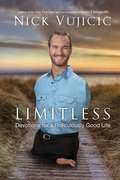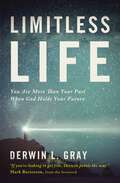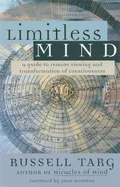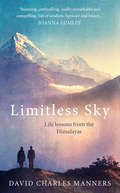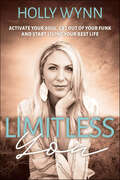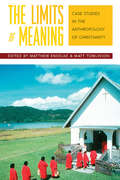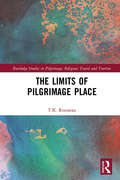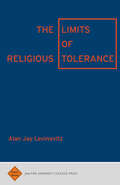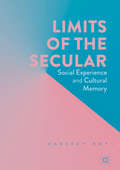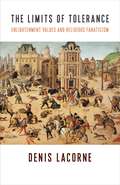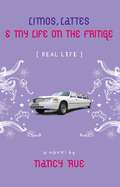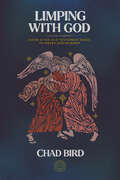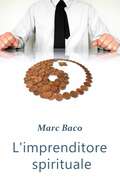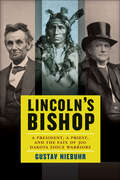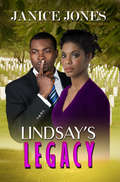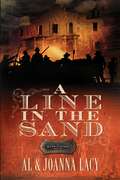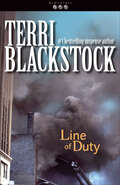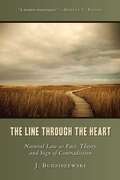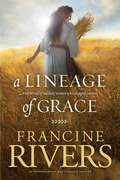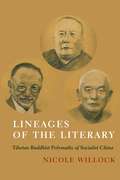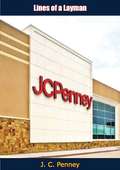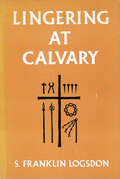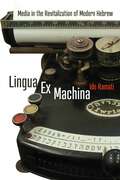- Table View
- List View
Limitless: Devotions for a Ridiculously Good Life
by Nick VujicicFrom limbless to limitless - anything is possible with God! Nick Vujicic knows there is no greater hope than trusting in God's plan for your life. Born without arms or legs, Nick has experienced both the peak of hope and the depth of despair. But he has overcome his circumstances and physical limitations by clinging to his faith and understanding the limitless love and power God has for every person. Now he wants you to experience that same reassurance of hope and the power of God, everyday. In these fifty inspirational devotions, Nick shares his most compelling, hard-earned wisdom to help you face obstacles with confidence and courage and point you toward God. Whether you struggle with faith, relationships, career challenges, anger, health concerns, self-esteem, finding balance, or doubt in your dreams, Nick's biblical encouragement and positive attitude will transform your life and show you that you can be limitless because God is limitless. "Now to him who is able to do immeasurably more than all we ask or imagine, according to his power that is at work within us, to him be glory in the church and in Christ Jesus throughout all generations, forever and ever! Amen" (Ephesians 3:20-21).
Limitless Life: You Are More Than Your Past When God Holds Your Future
by Derwin L. GrayIs your life limited by labels the world and other people have used to define you? Labels you have internalized and apply to yourself every day. Labels like Afraid. Or Addict. Orphan. Damaged Goods. Failure. Maybe even Religious. These labels might be sewn into your life with such tight little stitches that they feel like a part of you. They feel like they define you. But that's a lie. If you let Him, Jesus can remove those old labels and tattoo new ones onto your soul. Then you'll begin to see yourself as God the Father sees you. The limits will be lifted, and your life will be transformed. It's the truth. Join Pastor Derwin Gray on a fascinating journey into what can happen when you offer your head, your heart, and your hands to the only one who can offer you truly limitless life.
Limitless Mind: A Guide to Remote Viewing and Transformation of Consciousness
by Russell TargFor those interested in psychic phenomena such as remote viewing, out-of-body experiences, precognition and healing at a distance this books is a must read. Targ explores its scientific as well as spiritual implications and offers techniques and exercises to nurture this universal but mostly untapped psychic skills.
Limitless Sky: Life lessons from the Himalayas
by David Charles MannersThis is the remarkable true story of a young man's initiation in the Himalayas. David Manners was trekking in Nepal when he stumbled upon the mountain home of a jhankri, or Nepalese shaman. The jhankri accepted David as his pupil, and so began the next stage of David's extraordinary journey, in which he embarked upon an adventure that was more challenging and, ultimately, life-affirming than anything he could have imagined. In Limitless Sky, David shares the wisdom and insights he learnt from those transformational days in the Himalayas. These include practical guidance on how to live a full and fearless life, how to find happiness and how to live in ways that nurture both ourselves and others. As David reveals, the life lessons he learned amongst the mountains of the Himalayas could benefit us all today.
Limitless You: Activate Your Soul, Get Out of Your Funk and Start Living Your Best Life
by Holly WynnLimitless You helps those seeking to live fully become more self-aware of their emotions and thoughts, by identifying the tricks and traps of the mind and creating the life they deserve to live. Every person is born with a beautiful purpose for their lives; yet past experiences, societal expectations, and accumulated trauma leave many feeling unworthy and fearful of pursuing their passions. The tricks and traps of the brain can convince anyone to move through life with their heads down, eyes glazed, but according to Holly Wynn, human beings aren’t meant to go through the motions!Too many interpret their inner voice saying, “I can’t live like this anymore,” as instruction to remove themselves from this life altogether, rather than an invitation to take steps toward meaningful changes to make life better. In the aftermath of COVID-19’s “new normal,” personal loss and tragedy are far too common, leaving individuals feeling trapped. In Limitless You, Holly Wynn encourages readers to take action, unlocking the door to their heart and embracing the purpose they were meant for.
The Limits Of Meaning
by Matt Tomlinson Matthew EngelkeToo often, anthropological accounts of ritual leave readers with the impression that everything goes smoothly, that rituals are "meaningful events." But what happens when rituals fail, or when they seem "meaningless"? Drawing on research in the anthropology of Christianity from around the globe, the authors in this volume suggest that in order to analyze meaning productively, we need to consider its limits. This collection is a welcome new addition to the anthropology of religion, offering fresh debates on a classic topic and drawing attention to meaning in a way that other volumes have for key terms like "culture" and "fieldwork.
The Limits of Pilgrimage Place (Routledge Studies in Pilgrimage, Religious Travel and Tourism)
by T.K RousseauThrough case studies of three pilgrimage sites related to the Virgin Mary, this book explores how pilgrimage places in today’s globalized world do not exist as contained spaces but have porous boundaries, both physically and conceptually. Taking an interdisciplinary approach that draws on art history and heritage studies, the book considers the cathedral of Chartres, France; Medjugorje in Bosnia and Herzegovina; and the House of Mary near Ephesus, Turkey. In all three sites, the place of pilgrimage accommodates multiple different purposes and groups of people, intermingling devotional and commercial aspects, different memory narratives, and heterogeneous audiences. By mapping these porous boundaries, the book calls into question how we define pilgrimage place, and shows how pilgrimage sites are not set apart from the everyday world, but intimately connected with wider cultural, political, and material dynamics. This study will be relevant to scholars engaging with issues of pilgrimage, cultural heritage, and art across religious studies, art history, anthropology, and sociology.
The Limits of Religious Tolerance
by Alan Jay LevinovitzReligion’s place in American public life has never been fixed. As new communities have arrived, as old traditions have fractured and reformed, as cultural norms have been shaped by shifting economic structures and the advance of science, and as new faith traditions have expanded the range of religious confessions within America’s religious landscape, the claims posited by religious faiths—and the respect such claims may demand—have been subjects of near-constant change. In The Limits of Religious Tolerance, Alan Jay Levinovitz pushes against the widely held (and often unexamined) notion that unbounded tolerance must and should be accorded to claims forwarded on the basis of religious belief in a society increasingly characterized by religious pluralism. Pressing at the distinction between tolerance and respect, Levinovitz seeks to offer a set of guideposts by which a democratic society could identify and observe a set of limits beyond which religiously grounded claims may legitimately be denied the expectation of unqualified non-interference.
Limits of the Secular
by Kaustuv RoyThis book facilitates a missing dialogue between the secular and the transsecular dimensions of human existence. It explores two kinds of limits of the secular: the inadequacies of its assumptions with respect to the total being of the human, and how it curbs the ontological sensibilities of the human. Kaustuv Roy argues that since secular reason of modernity can only represent the empirical dimension of existence, humans are forced to privatize the non-empirical dimension of being. It is therefore absent from the social, imaginary, as well as public discourse. This one-sidedness is the root cause of many of the ills facing modernity. Roy contends that a bridge-consciousness that praxeologically relates the secular and the non-secular domains of experience is the need of the hour.
The Limits of Tolerance: Enlightenment Values and Religious Fanaticism (Religion, Culture, and Public Life #4)
by Denis LacorneThe modern notion of tolerance—the welcoming of diversity as a force for the common good—emerged in the Enlightenment in the wake of centuries of religious wars. First elaborated by philosophers such as John Locke and Voltaire, religious tolerance gradually gained ground in Europe and North America. But with the resurgence of fanaticism and terrorism, religious tolerance is increasingly being challenged by frightened publics.In this book, Denis Lacorne traces the emergence of the modern notion of religious tolerance in order to rethink how we should respond to its contemporary tensions. In a wide-ranging argument that spans the Ottoman Empire, the Venetian republic, and recent controversies such as France’s burqa ban and the white-supremacist rally in Charlottesville, The Limits of Tolerance probes crucial questions: Should we impose limits on freedom of expression in the name of human dignity or decency? Should we accept religious symbols in the public square? Can we tolerate the intolerant? While acknowledging that tolerance can never be entirely without limits, Lacorne defends the Enlightenment concept against recent attempts to circumscribe it, arguing that without it a pluralistic society cannot survive. Awarded the Prix Montyon by the Académie Française, The Limits of Tolerance is a powerful reflection on twenty-first-century democracy’s most fundamental challenges.
Limos, Lattes and My Life on the Fringe (Real Life #4)
by Nancy N. RueFrom bestselling author Nancy Rue comes a YA contemporary novel where prom season takes on a deeper meaning, as a girl nominated for prom queen as a joke decides to use the opportunity as a way to empower her fellow classmates. And ends up questioning her self-perceptions in the process.For Tyler Bonning, not caring what others think is her super power. As is her ability to find the perfect, cutting response. All she needs to be happy is her group of equally smart and quirky friends and high grades to get into a good college. Then she&’s nominated for prom queen as a joke.Deciding to make the most of the opportunity—and mask her pain—Tyler starts a Prom for Everyone campaign intended help make the event more affordable. In the process, she discovers the way she&’s perceived by her classmates—as well as her supposedly close friends—may actually be more important than she thought. And she doesn&’t like the person they perceive her to be. With her parents pressuring her to focus on the racial issues at school instead of a frivolous cause, and a growing closeness to a boy who represents everything she once mocked, Tyler questions who she really wants to be. And as prom approaches, she faces her biggest challenge yet. One she can&’t handle on her own.Limos, Lattes & My Life on the Fringe:features a diverse main protagonistfocuses on the ideas of self and identity, and what we let define and divide usprovides an inspirational message for those dealing with tough circumstancesis the final book in the Real Life series, but can also be read as a stand-alone novel
Limping with God: Jacob & The Old Testament Guide to Messy Discipleship
by Chad BirdJacob seems to be anything but a model disciple. He's a trickster, liar, and selfishly ambitious man who fathers children with four women and leads a dysfunctional family rife with jealousy and backstabbing. But Jacob is also Israel, the namesake of the Old Testament community of God, chosen and blessed. As such, this sinner-saint, who limps along with the Lord, burdened by weakness and beset by problems, is the mirror image of all of us who follow Jesus. In his life we see our lives, our struggles, our failures, and most especially the God who loves us and chooses us as his own. As we explore his bio, from his wrangling in the womb with Esau to his death as an old man in Egypt, we will learn more about ourselves and the God who is with us and for us in Jesus the Messiah.
L'imprenditore spirituale
by Marc BacoL’imprenditore spirituale si differenzia dalle sue controparti “materialiste” perché applica le leggi spirituali nel suo lavoro. Alcune indicazioni su questo tema vengono fornite nel corso del libro.
Lincoln's Bishop: A President, A Priest, and the Fate of 300 Dakota Sioux Warriors
by Gustav NiebuhrA history of the Dakota War of 1862, an Episcopal bishop, and his campaign to protect the lives of the Dakota Sioux.It is hard to recall what powerful moral voices Protestant church leaders had in the formative years of the nation. Gustav Niebuhr travels back to the Minnesota frontier of 1862 when Dakota Sioux rose up against pioneering families and slaughtered hundreds. Citizens demanded mass executions and deportations. Into this turmoil stepped Henry Benjamin Whipple, the state’s first Episcopal bishop.Whipple had already loudly decried the crimes and corruption of those managing Indian affairs and warned of calamity. Now he made the case of mercy and a deeper justice, which eventually led to meeting with President Lincoln. Despite being preoccupied with the Civil War, Lincoln was moved to intervene, surprisingly taking the time to review all 303 cases and overturning the death sentence for most of the Indians. Nevertheless, the result was still the largest single execution on American soil.If not for Whipple’s vigorous campaigning, both in state and in Washington, DC, a greater tragedy might well have occurred. His success should haunt us: Where today do we hear these trumpet calls for justice like those given by figures such as Bishop Henry Benjamin Whipple?“[An] enlightening tale of Abraham Lincoln’s other war. . . . A pleasant surprise for the average history buff.” —Kirkus Reviews
Lincoln's God: How Faith Transformed a President and a Nation
by Joshua ZeitzLincoln&’s spiritual journey from spiritual skeptic to America's first evangelical Christian presidentbeliever—a conversion that changed both the Civil War and the practice of religion itself.Abraham Lincoln, unlike most of his political brethren, kept organized Christianity at arm&’s length. He never joined a church and only sometimes attended Sunday services with his wife. But as he came to appreciate the growing political and military importance of the Christian community, and when death touched the Lincoln household in an awful, intimate way, the erstwhile skeptic effectively evolved into a believer and harnessed the power of evangelical Protestantism to rally the nation to arms. The war, he told Americans, was divine retribution for the sin of slavery. This is the story of that transformation and the ways in which religion helped millions of Northerners interpret the carnage and political upheaval of the 1850s and 1860s. Rather than focus on battles and personalities, Joshua Zeitz probes ways in which war and spiritual convictions became intertwined. Characters include the famous—Harriet Beecher Stowe, Frederick Douglass, Henry Ward Beecher—as well as ordinary soldiers and their families whose evolving understanding of mortality, heaven, and mission motivated them to fight. Long underestimated in accounts of the Civil War, religion—specifically evangelical Christianity—played an instrumental role on the battlefield and home front, and in the corridors of government. More than any president before him—or any president after, until George W. Bush—Lincoln harnessed popular religious enthusiasm to build broad-based support for a political party and a cause. A master politician who was sincere about his religion, Lincoln held beliefs that were unconventional—and widely misunderstood then, as now. After his death and the end of an unforgiving war, Americans needed to memorialize Lincoln as a Christian martyr. The truth was, of course, considerably more complicated, as this original book explores.
Lindsay's Legacy
by Janice JonesLindsay Renee Westbrook Taylor, a Christian young woman better known as Nay or Nay-Nay, was married to Shaun Taylor, a notorious Detroit City drug dealer, until his swift and untimely murder. Their marital union was plagued with baby mama drama, infidelity, deadly violence and in-law issues. Now widowed and walking even closer to Christ, Lindsay is remarried to Shaun's former attorney, Cody Vincini. Lindsay feels like she has been blessed with God's ultimate favor in her new life. However, she soon discovers that the sins, secrets, and mistakes of her past are rampantly invading her present and weaving dangerous and destructive paths to her very uncertain future. Will Lindsay stand firm in her faith this time and let God guide her through the dramatic twists and turns of her new life, or will she again let human nature rule her decisions, actions, and reactions? Can she avoid getting pulled back into the situations she barely escaped before and walk away again with everything, including her life, intact?
A Line in the Sand (Kane Legacy #1)
by Al Lacy Joanna LacyThe Kane Legacy: faith, love, courage, and strength. In nineteenth-century Texas, they're going to need it. In 1835, Alan Kane and his family come to the Circle C Ranch in Texas, little dreaming what the future holds in both blessing and danger. Beautiful Julia Miller, daughter of a Louisiana plantation owner, has captured Alan's heart, but he hardly dares to hope for her hand. Then Colonel William Travis calls for the men of Texas to rally against Mexico's General Santa Anna. Full of honor and courage, brothers Alan and Adam join up with Jim Bowie to do their part. The plan centers on holding a Franciscan mission known as the Alamo and soon includes Davy Crockett and his Tennessee Mounted Volunteers. As battle looms, what is God's purpose for the Kane men? Can they share their eternal hope with men ready to die for Texas? Will brotherly bonds overcome a jealous secret in the face of death? And just what will endure of the Kane legacy? From the Trade Paperback edition.
Line of Duty (Newpointe 911 #5)
by Terri BlackstockAt the request of her many fans—Terri Blackstock revisits the heroic cast of characters in this fifth book in her best-selling Newpointe 911 series In Line of Duty, a bomb explodes at the Icon International building in New Orleans while lawyer Jill Clark Nichols is in the top floor boardroom. The thirty-story building goes up in flames and fire departments from all around the area are called in. The firefighters from Newpointe are especially concerned since they know Jill is inside the building. Dan, her husband, rushes in to save her. But as firefighters work to evacuate the upper floors of the building, a second and third bomb explode, causing the lower floors to cave in. Firefighters and civilians are buried beneath the rubble. When the smoke finally clears, a count is taken. Jill narrowly escapes the chaos of the explosions and fire only to find Dan missing. Were the bombs the act of a terrorist, or a scheme coming from a heart of greed? Can Jill&’s faith carry her through these long days of pain and uncertainty? And will Dan survive this tragedy . . . or sacrifice his life in the line of duty?
The Line Through the Heart: Natural Law as Fact, Theory, and Sign of Contradiction
by J. BudziszewskiWhy do we demand happiness on terms that make happiness impossible? And what can we do about it? Acclaimed philosopher J. Budziszewski addresses these questions in the brilliantly persuasive book The Line Through the Heart, finding the answers in the natural law. The journey of exploration takes us through politics, religion, ethics, law, philosophy, and more, with Budziszewski as expert guide. While investigating the natural law and its implications, Budziszewski boldly confronts a wide range of contemporary issues, offering a newly integrated view of abortion, evolution, euthanasia, capital punishment, runaway courts, and the ersatz state religion built in the name of religious toleration. Written in Budziszewski's usual crystalline style, The Line Through the Heart shows that natural law is a matter of concern not merely to scholars but to everyone, for it touches how each of us lives, and how all of us live together. His profound examination of this subject helps us make sense of why habits that run against our nature have become second nature, and why our world seems to be going mad.
A Lineage of Grace: Five Stories of Unlikely Women Who Changed Eternity
by Francine RiversBack Cover: This book consists of five expanded Biblical stories telling about the five women whom God chose. These Biblical women are in the lineage of Jesus Christ, the Savior of the world according to Christians and Messianic Jews. “TAMAR Betrayed by the men who controlled her future, she fought for her right to believe in a loving God. RAHAB A woman with a past to whom God gave a future. RUTH She gave up everything, expecting nothing, and God honored her. BATHSHEBA Her beauty stirred the passion of a king. Her pain moved the heart of God. MARY All eternity had been waiting for this moment. She responded in simple obedience to God's will. Each woman's story includes a six part Bible study, perfect for personal study or group discussion.”
Lineages of the Literary: Tibetan Buddhist Polymaths of Socialist China
by Nicole WillockIn the aftermath of the cataclysmic Maoist period, three Tibetan Buddhist scholars living and working in the People’s Republic of China became intellectual heroes. Renowned as the “Three Polymaths,” Tséten Zhabdrung (1910–1985), Mugé Samten (1914–1993), and Dungkar Lozang Trinlé (1927–1997) earned this symbolic title for their efforts to keep the lamp of the Dharma lit even in the darkest hour of Tibetan history.Lineages of the Literary reveals how the Three Polymaths negotiated the political tides of the twentieth century, shedding new light on Sino-Tibetan relations and Buddhism during this turbulent era. Nicole Willock explores their contributions to reviving Tibetan Buddhism, expanding Tibetan literary arts, and pioneering Tibetan studies as an academic discipline. Her sophisticated reading of Tibetan-language sources vivifies the capacious literary world of the Three Polymaths, including autobiography, Buddhist philosophy, poetic theory, and historiography. Whereas prevailing state-centric accounts place Tibetan religious figures in China in one of two roles, collaborator or resistance fighter, Willock shows how the Three Polymaths offer an alternative model of agency. She illuminates how they by turns safeguarded, taught, and celebrated Tibetan Buddhist knowledge, practices, and institutions after their near destruction during the Cultural Revolution.An interdisciplinary work spanning religious studies, history, literary studies, and social theory, Lineages of the Literary offers new insight into the categories of religion and the secular, the role of Tibetan Buddhist leaders in modern China, and the contested ground of Tibet.
Lines of a Layman
by J. C. PenneyThe history of America’s commercial growth is highlighted with the names of a few great men whose contributions to their nation have far transcended ability in business, manufacturing and industry. Elbert Hubbard, John Wanamaker—these men were merchant princes in one sense, leaders of thought and belief in another. Through their autobiographical writings and essays, they have given us a rich, poignant, inspiring picture of their fruitful lives and careers. Their words point the way to meaningful, creative, productive and brotherly living.Such a man is J. C. Penney, at once the most successful of our times in business enterprise, and the most inspiring in his personal example of courage, wisdom, and service to fellow men and to God.Faith and fellowship are no mere Sunday things in J. C. Penney’s philosophy. You find a twenty-four-hour-a-day, seven-day-a-week code of Christian living in such pieces as his Six Principles for Daily Living, The Four Square Man, and The Christian and the Social Order. They are “the measure of the man.”You will find LINES OF A LAYMAN more than a book to read, although its almost 200 thoughtful vignettes are fascinating, swift-paced and stimulating. You will find that it is a book to use, even a book to live by. Its pages are charged with meaning; one cannot read them without finding new ways to happiness and creativity.
Lingering at Calvary
by S. Franklin LogsdonYears ago a large painting of the cruxifixion was lent to a Midwestern city for exhibition during the Easter season. Space in a department store was set aside for the exquisite work which finally was recessed in yards and yards of rich, dark blue velvet. Approximately a hundred chairs were placed at a distance from the picture for the public to view it during business hours. You could step inside that enclosed space at any hour of the day and find people sitting and standing in absolute silence as they gazed at the scene before them. The awe and worshipful reverence of the spectators can be described best by saying they could be felt.Remembrance of that place and picture can be relived in the content of Lingering at Calvary. How could the author forbear to do anything else than employ fully his gift of words in applying one brushful after another to the Calvary scene! He wants to stop readers who live much of their lives in this noncontemplative age of rush, pleasure, and ungodliness—stop them, make them sit or stand for a time in the absolute, tearful silence of sheer gratitude.
Lingering at Calvary
by S. Franklin LogsdonYears ago a large painting of the cruxifixion was lent to a Midwestern city for exhibition during the Easter season. Space in a department store was set aside for the exquisite work which finally was recessed in yards and yards of rich, dark blue velvet. Approximately a hundred chairs were placed at a distance from the picture for the public to view it during business hours. You could step inside that enclosed space at any hour of the day and find people sitting and standing in absolute silence as they gazed at the scene before them. The awe and worshipful reverence of the spectators can be described best by saying they could be felt.Remembrance of that place and picture can be relived in the content of Lingering at Calvary. How could the author forbear to do anything else than employ fully his gift of words in applying one brushful after another to the Calvary scene! He wants to stop readers who live much of their lives in this noncontemplative age of rush, pleasure, and ungodliness—stop them, make them sit or stand for a time in the absolute, tearful silence of sheer gratitude.
Lingua Ex Machina: Media in the Revitalization of Modern Hebrew (Jewish Culture and Contexts)
by Ido RamatiAn investigation of the connections between the parallel rise of modern Hebrew and modern mediaAfter lying dormant for two millennia as a mainly written language, Hebrew awoke from its literary slumber to become a living modern vernacular. This revitalization is unique and unprecedented in world history, and its success has been studied in fields from linguistics to cultural history. However, the role of modern technologies in mediating this revival has not yet been considered.What happens when an ancient language meets modern technology? Lingua Ex Machina explores such a moment in its investigation of the role media technologies—including typewriters, phonographs, and computers—played in the revitalization and modernization of Hebrew from the end of the nineteenth century into the present day.Ido Ramati examines the role sound recording technologies played in shaping the reemergence of modern Hebrew speech, reveals how the Hebraized typewriter pushed for the modernization of writing in Hebrew, and ultimately argues that these media—whose development and adoption paralleled the revitalization of Hebrew—were an active force in shaping the language as a modern communicative medium. This case study of Hebrew furnishes researchers with a rare opportunity to investigate the complex relation between language, its speakers, and technology at a decisive moment, and sheds new light on the study of media technologies and their theoretical, lingual, and social implications.
